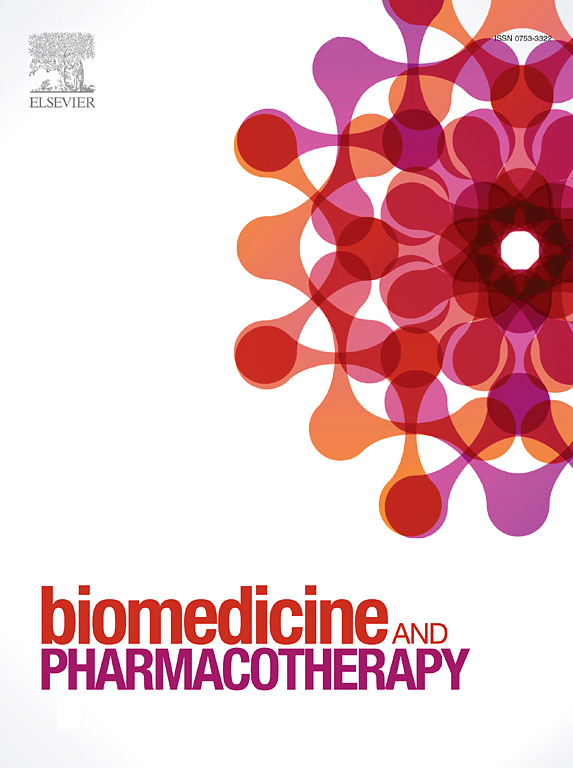新型外周限制性CB1受体拮抗剂PMG-505-010和-013可改善与肥胖相关的非酒精性脂肪肝和纤维化。
IF 6.9
2区 医学
Q1 MEDICINE, RESEARCH & EXPERIMENTAL
引用次数: 0
摘要
内源性大麻素系统在新陈代谢调节中起着至关重要的作用,这促使人们开始研究大麻素 1 型受体(CB1R)拮抗剂,以治疗肥胖症及其并发症,如非酒精性脂肪肝(NAFLD)。由于对精神疾病副作用的担忧,人们开发了可绕过血脑屏障(BBB)的外周 CB1R 拮抗剂。在这项研究中,我们对利莫那班进行了改良,最大程度地减少了血脑屏障的渗透,从而合成了PMG-505-010和PMG-505-013,作为外周限制性CB1受体拮抗剂。理化分析证实,与利莫那班相比,这两种药物的亲脂性降低,极性增加,表明它们在大脑中的暴露有限。分子对接研究显示,它们在 CB1R 上的结合模式与利莫那班相似,具有强大的疏水相互作用。在功能上,它们既是 CB1R 拮抗剂,又是反向激动剂,能有效逆转 CP55,940 诱导的 cAMP 抑制作用。在肥胖相关的非酒精性脂肪肝小鼠模型中,PMG-505-010 和 -013 改善了代谢状况,包括空腹血糖水平和血脂异常。它们还能改善肝损伤、脂肪变性和炎症,具体表现为肝酶、脂质过氧化、肝脂水平和炎症细胞因子水平的降低。值得注意的是,这些化合物通过减少细胞外基质(ECM)沉积和改变纤维化相关基因和蛋白的表达,抑制了肝纤维化。总之,PMG-505-010和PMG-505-013有望通过选择性外周CB1R靶向治疗肥胖相关肝病,包括非酒精性脂肪肝和肝纤维化,从而可能避免早期CB1R拮抗剂出现的与中枢神经系统相关的副作用。本文章由计算机程序翻译,如有差异,请以英文原文为准。
New peripherally-restricted CB1 receptor antagonists, PMG-505–010 and −013 ameliorate obesity-associated NAFLD and fibrosis
The endocannabinoid system plays a crucial role in metabolic regulation, prompting the investigation of cannabinoid type 1 receptor (CB1R) antagonists for obesity and its complications like non-alcoholic fatty liver disease (NAFLD). Concerns over psychiatric side effects led to the development of peripheral CB1R antagonists that circumvent the blood-brain barrier (BBB). In this study, we synthesized PMG-505–010 and PMG-505–013 as peripherally restricted CB1 receptor antagonists by modifying rimonabant to minimize BBB penetration. Physicochemical analysis confirmed their reduced lipophilicity and increased polarity compared to rimonabant, indicating limited brain exposure. Molecular docking studies revealed similar binding modes to rimonabant at CB1R, characterized by robust hydrophobic interactions. Functionally, they acted as CB1R antagonists and inverse agonists, effectively reversing CP55,940-induced cAMP inhibition. In a murine model of obesity-related NAFLD, PMG-505–010 and −013 improved metabolic profiles, including fasting blood glucose levels and dyslipidemia. They also ameliorated hepatic injury, steatosis, and inflammation, evidenced by reduced liver enzymes, lipid peroxidation, hepatic lipid levels, and inflammatory cytokine levels. Notably, these compounds inhibited hepatic fibrosis by reducing extracellular matrix (ECM) deposition and altering fibrosis-related gene and protein expressions. In conclusion, PMG-505–010 and PMG-505–013 hold promise for treating obesity-related liver diseases, including NAFLD and fibrosis, through selective peripheral CB1R targeting, potentially avoiding CNS-related side effects seen with earlier CB1R antagonists.
求助全文
通过发布文献求助,成功后即可免费获取论文全文。
去求助
来源期刊
CiteScore
11.90
自引率
2.70%
发文量
1621
审稿时长
48 days
期刊介绍:
Biomedicine & Pharmacotherapy stands as a multidisciplinary journal, presenting a spectrum of original research reports, reviews, and communications in the realms of clinical and basic medicine, as well as pharmacology. The journal spans various fields, including Cancer, Nutriceutics, Neurodegenerative, Cardiac, and Infectious Diseases.

 求助内容:
求助内容: 应助结果提醒方式:
应助结果提醒方式:


